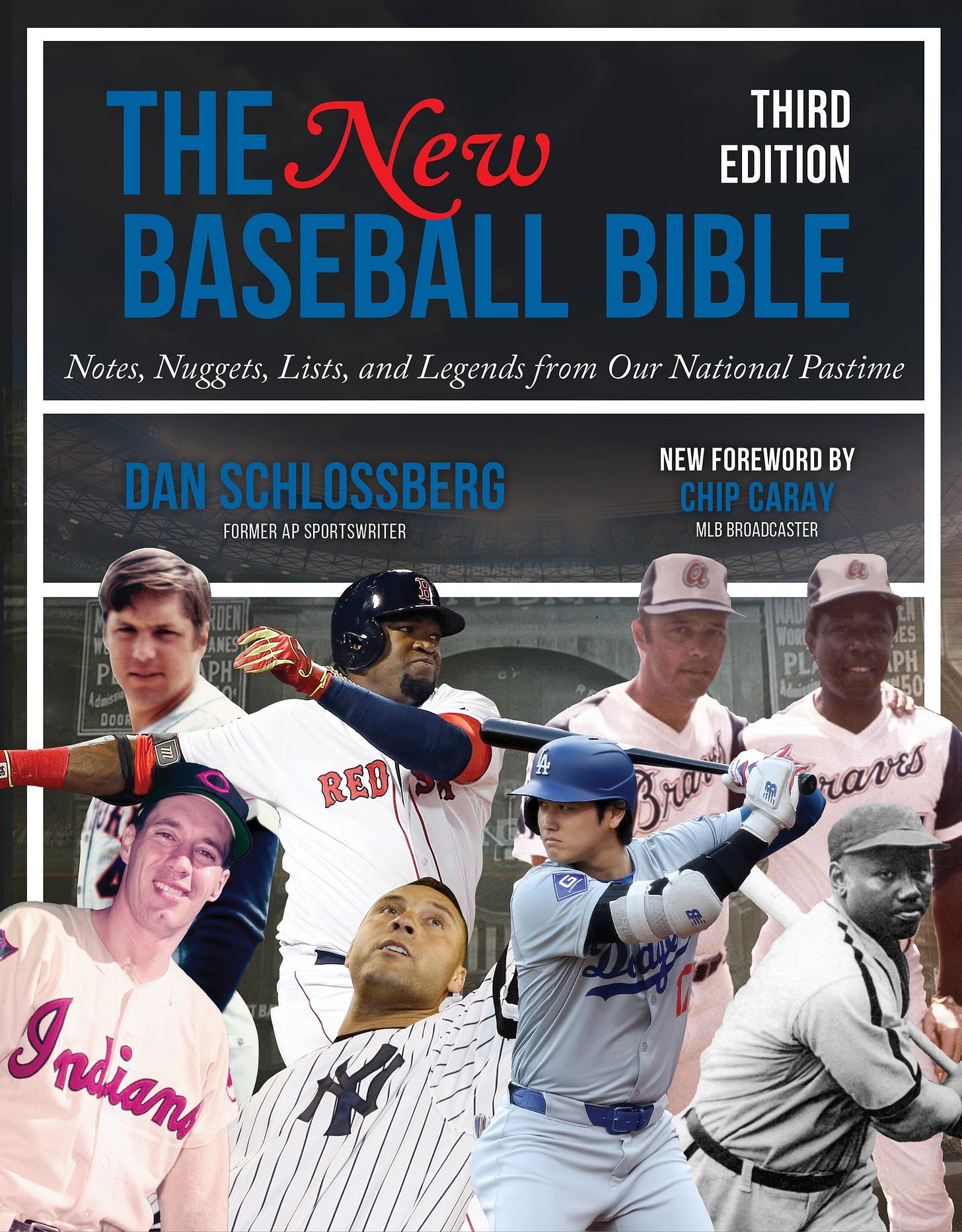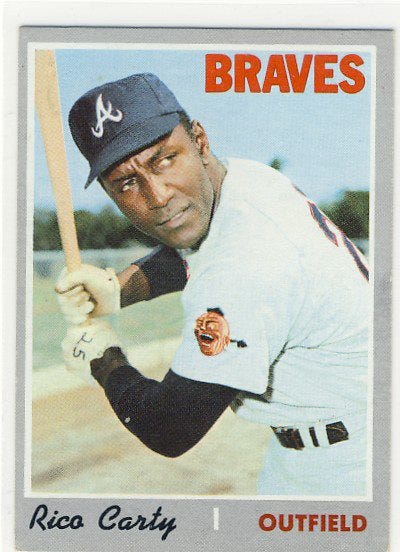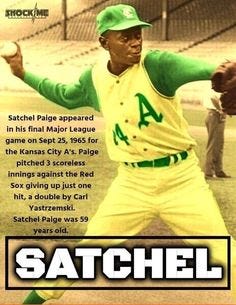Recalling League Leaders of the '70s
...AND SOME FAMOUS NICKNAMES TOO
IBWAA members love to write about baseball. So much so, we've decided to create our own newsletter about it! Subscribe to Here's the Pitch to expand your love of baseball, discover new voices, and support independent writing. Original content six days a week, straight to your inbox and straight from the hearts of baseball fans.
HtP Weekend Editor To Discuss New Book On MLB Network Tuesday
Here’s the Pitch weekend editor Dan Schlossberg will discuss his latest book, The New Baseball Bible, with host Brian Kenny of MLB Now at 12:35 on Tuesday, May 13th. The 500-page book has 25 chapters, many full-color pictures, and exclusive contributions by Chip Caray, John Thorn, and former Hall of Fame president Jeff Idelson. The unorthodox illustrated history, created as both a coffee-table book and a bathroom book, will be published June 3.
Pregame Pepper
Did you know…
The Kansas City Royals went into Camden Yards with a majors-worst 18 homers in their first 34 games — and then hit a club-record seven against the beleaguered Baltimore pitching staff . . .
Unhappy after moving the fences back 26 feet last year, the Orioles reversed course — only to re-create a ridiculous situation for their aged pitching staff . . .
Charlie Morton, 41, was pounded in his first relief outing, which he departed with an ERA of 9.76 . . .
Kyle Gibson, brought back as a late-signing free agent, hasn’t been much better . . .
Unless things improve dramatically, the last-place O’s are certain to be sellers when the July 31 trade deadline arrives . . .
It’s impossible to blame free agent deserters Anthony Santander or Corbin Burnes, both off to weak starts with their new teams after bolting Baltimore.
Leading Off
Surprising League Leaders of the 1970s
By Paul Semendinger
When I conducted my research for my articles on the best Seattle Pilots players of all time, I learned that Diego Segui led the American League in ERA in 1970. Over the course of my lifetime following baseball, I never knew that Segui had a singular season that was so good.
I soon began to wonder about other lesser-known players who led their league in traditional categories in the 1970s. I found that there were more than I imagined! As such, I made a list.
While the following players are not remembered as stars today, for one season at least, they were something very special:
Diego Segui, 1970 A.L. ERA Title (2.56): Segui pitched for 15 seasons, but this was the only time he led the league in any positive category. Segui did lead the A.L. in losses in 1964.
Alex Johnson, 1970 A.L. Batting Champion (.329): Johnson had a 13-year career. This was the only time he led the league in any category. This was his third consecutive season batting over .300, though he'd never reach that mark again in his career.
Rico Carty, 1970 N.L. Batting Champion (.366): Carty played for 15 seasons. Like Alex Johnson, this was the only time he led the league in any traditional category, though he did hit .342 the year before. (In 1970, Carty also led the league in On-Base Percentage, but that wasn't as much of a common statistic at the time).
Bill Melton, 1971 A.L. Home Run Champ (33): Melton played in the big leagues for 10 seasons. He hit 33 homers in 1970 and then again in 1971 (to lead the league). Melton never hit 30 homers in any other season and never led the league in any other categories.
Pedro Garcia, 1973 A.L. Doubles Leader (32, Tie): A rookie in 1973, Garcia batted only .245 and was runner-up for the Rookie of the Year. Garcia's career was a short one, playing only five seasons. He never led the league in any other category. More than one-third of his career doubles came in this one season.
Ron Bryant, 1973 N.L. Wins Leader (24): Bryant had an eight-year career. He won 57 total games, but 24 of them came in his 1973 season when he led the league. He never led the league in any other category in his career.
Buzz Capra, 1974 N.L. ERA Title (2.28): Capra played for seven seasons. Along with his great ERA in 1974, Capra went 16-8, the only season in which he had a winning record.
Larry Hisle, 1977 A.L. RBI Leader (119): Hisle was a big-leaguer for 14 years. He never led the league in any category except for this one instance. Hisle only exceeded 100 runs batted in one other time in his career (1978).
Dave Goltz, 1977 A.L. Wins Leader (20, Tie): Goltz played for 12 seasons. While this was his only time leading the league in any positive category (he led the league in hits allowed twice and wild pitches once), he was better than he is remembered. Goltz averaged 15.4 wins over a five-year period from 1975 through 1979.
Craig Swan, 1978 N.L. ERA Title (2.43): Swan, like Goltz, pitched for 12 seasons. His lifetime record was only 59-72, but he did have this one excellent season.
This all got me thinking... I wonder what little-known or remembered players led the league in various categories in the 1960s...
Paul Semendinger has authored many books including From Compton to the Bronx (with Roy White) and The Least Among Them. Paul has also been published by SABR and the IBWAA on some great anthologies of baseball. Paul still plays too; he had the pleasure of pitching on Monte Irvin Field in Orange, NJ last Sunday. Paul earned the win for his team! He urges readers to take a moment this weekend and wish those who you love and care for a Happy Mothers' Day.
Cleaning Up
Baseball’s Best Players Often Had Best Nicknames
By Dan Schlossberg
Seeing the name Buzz Capra in Paul Semendinger’s Leading Off piece above, I started thinking about memorable baseball nicknames — at least those we could print.
Lee William Capra, given his nickname by a neighbor in suburban Chicago, was not a memorable player, except perhaps to Braves fans who remembered his remarkable and unexpected contributions to that club’s 1974 pitching staff.
Plenty of other Braves with nicknames were, however.
How about Hall of Famers Hammerin’ Hank Aaron, Larry (Chipper) Jones, and Phil (Knucksie) Niekro, for example?
Cooperstown is filled with personalities known by nicknames.
George Herman (Babe) Ruth had many, including The Bambino, The Sultan of Swat, and Jidge, a derivation of his actual first name.
Three other Hall of Famers named George at birth were George Thomas Seaver, the pitcher; George (Sparky) Anderson, the manager; and George (Mule) Haas, fleet center fielder for the old Philadelphia Athletics. Manager Jimmie Dykes referred to Haas as “The Donkey” or “Donk,” while the first Frank Thomas (not the Hall of Famer) was called Dnkey because of his big ears.
Mickey Mantle’s real first name was Mickey but the man he was named after — Mickey Cochrane — was originally named Gordon Stanley Cochrane.
Lefty Grove’s given name was Robert, while Lefty Gomez was Vernon Lewis Gomez.
Seaver was both Tom Terrific and “The Franchise.”
Plenty of players were named after animals.
Mark (the Bird) Fidrych, whose career fizzled in a flash, never pitched to Clarence (Choo-Choo) Coleman, who had a lifetime batting average of .197 and a fielding average not much higher than that.
Lou Gehrig was “The Iron Horse,” Harry Danning was “The Horse,” and Charles Radbourn became “Old Hoss” after he won a record 59 games in a season, proving his willingness to work.
Jimmie Foxx was not only “Double-X” but “The Beast.” That nickname would have also worked for the later Charlie “King Kong” Keller and Dave “Kong” Kingman.
Although Ted Williams was dubbed “The Splendid Splinter” because of his svelte but powerful physique, that nickname was too long to fit into headlines. So the Boston papers solved the problem but referring to him simply as “The Kid” (later adopted by Gary Carter).
Joe DiMaggio was “the Yankee Clipper” and Tris Speaker was “The Grey Eagle” but those names were not as easy to shorten as Edwin Snider’s “The Duke of Flatbush.”
Cal Ripken, Jr., who broke Gehrig’s record for consecutive games played, deserved his “Iron Man” title, used decades earlier by a durable New York Giants pitcher who pitched three doubleheaders and won them all in August 1903. Few fans knew “Iron Man” McGinnity’s real name was Joe.
Two other pitchers with notable nicknames were Mike (The Bear) Garcia and Fred (Big Bear) Hutchinson. Then there was hard-throwing closer Dick (The Monster) Radatz.
Baseball has had more than its share of players nicknamed Whitey — Edward Charles Ford and fellow Hall of Famer Dorrel Norman Elbert Herzog, to name two — and quite a few “Reds,” notably Albert (Red) Schoendienst and broadcaster Walter Lanier (Red) Barber.
Goose Goslin, Ducky Medwick, and David (Big Papi) Ortiz also answered to nicknames. Goslin’s real name was Leon Allen Goslin, while Medwick — the last man to win a Triple Crown in the National League — was simply Joe.
Another Goose — the Cooperstown closer surnamed Gossage — was actually Rich by birth and by performance.
And let’s not forget Leroy (Satchel) Paige, who was always schlepping a bag somewhere during his decades-long sojourn in the Negro Leagues.
Players called John Wagner “Honus” because that was the German translation of his given name. Charles Leo (Gabby) Hartnett talked a lot, diminutive Rabbit Maranville (real name Walter) had a nickname dictated by his size (or lack of it).
Almost left out of this article were George (Highpockets) Kelly, Mike (Pinky) Higgins, Willie (Stretch) McCovey, Hazen (KiKi) Cuyler, Derrel (Bud) Harrelson, Ken (Hawk) Harrelson, and Jim (Hippo) Vaughn, who weighed 230 and pitched half of the famed double no-hit game of Mat 2, 1917 against 260-pound Fred Toney, also known as “The Man Mountain from Tennessee.”
Not to mention Charles Arthur (Dazzy) Vance, Jerome Herman (Dizzy) Dean, and Harold (Pee Wee) Reese.
Hall of Famer Jim Palmer answered to “Cakes” because he deliberately ate pancakes the day he pitched. Wilmer (Vinegar Bend) Mizell hailed from that town in Alabama.
But the pitcher with the most authentic nickname was Denton True (Cy) Young, who was dubbed “Cyclone” after smashing a wooden backstop with his fastball.
There was only one Yogi, with Lawrence Peter Berra earning the famous monicker because a teammate thought he resembled an Indian yogi. At least he hit more home runs than Frank (Home Run) Baker, a spray hitter of the Dead Ball Era who somehow connected twice in the 1911 World Series.
Jim (Catfish) Hunter, a later Yankee than Yogi, got his nickname when enterprising Athletics owner Charlie Finley tried to inject more color into the game.
It worked, especially because he also hung the nickname “Blue Moon” on pitcher John Odom and had another pitcher whose actual name was Vida Blue.
And, by the way, the real name of one-time Atlanta catcher Biff Pocoroba was Biff.
As Charles Dillon “Casey” Stengel once said, “You could look it up.”
HtP Weekend Editor Dan Schlossberg of Fair Lawn, NJ has been writing baseball for more than 50 years. The author of 43 books, he is a national baseball writer for forbes.com, columnist for Sports Collectors Digest, and contributor to Memories & Dreams, USA TODAY Sports Weekly, and numerous other outlets. Dan’s e.mail is ballauthor@gmail.com.
Timeless Trivia: Hit Batsmen & More
Walter Johnson was also worried that his blazing fastball would kill somebody, since batters did not wear helmets during his heyday . . .
Johnson hit a record 205 batters, tops on that dubious career list and way ahead of fellow Hall of Famers Randy Johnson and Eddie Plank (tied with 190 apiece) . . .
The active leader is Baltimore greybeard Charlie Morton, whose 18 hit batsmen last year gave him 186 lifetime, tied with Tim Wakefield for the fourth most since 1900 . . .
Not surprised for Wakefield, who seldom knew where his knuckleball was going, but Morton is a normal fastball/curveball pitcher whose control is usually decent — or was when he was younger . . .
Also not surprising that a pitcher tied a record by playing for five different teams in a season last year: Mike Baumann was with Baltimore, Seattle, Miami, the L.A. Angels, and San Francisco, where he had a one-game cameo.
Know Your Editors
HERE’S THE PITCH is published daily except Sundays and holidays. Benjamin Chase [gopherben@gmail.com] handles the Monday issue with Dan Freedman [dfreedman@lionsgate.com] editing Tuesday and Jeff Kallman [easyace1955@outlook.com] at the helm Wednesday and Thursday. Original editor Dan Schlossberg [ballauthor@gmail.com], does the weekend editions on Friday and Saturday. Former editor Elizabeth Muratore [nymfan97@gmail.com] is now co-director [with Benjamin Chase and Jonathan Becker] of the Internet Baseball Writers Association of America, which publishes this newsletter and the annual ACTA book of the same name. Readers are encouraged to contribute comments, articles, and letters to the editor. HtP reserves the right to edit for brevity, clarity, and good taste.




